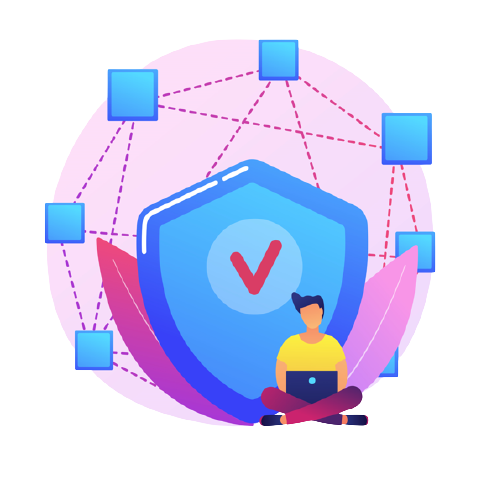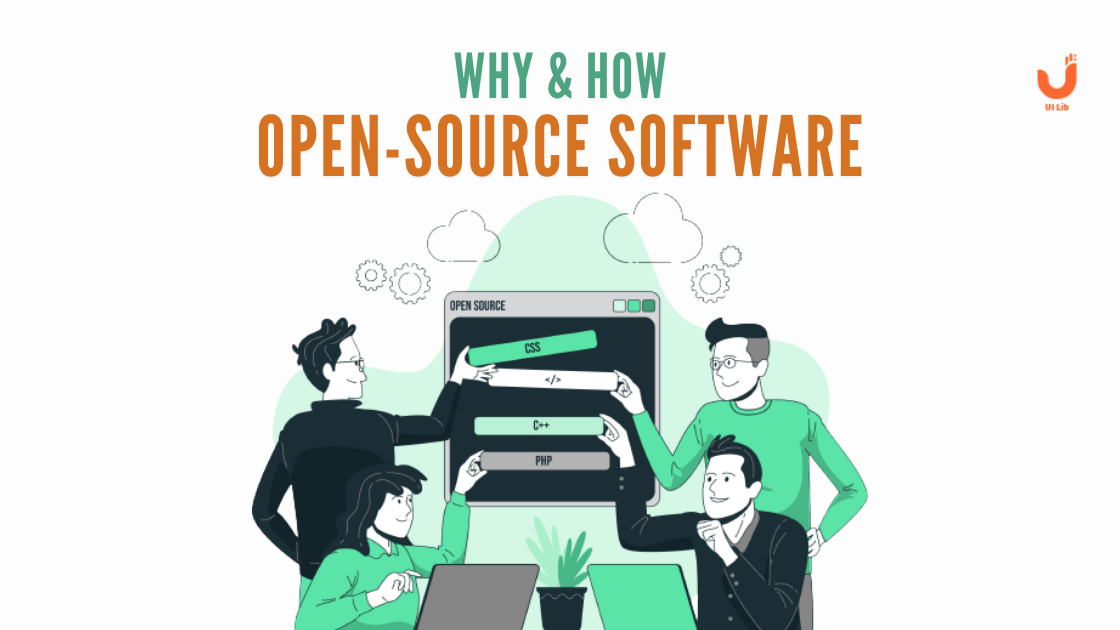Nowadays, developers frequently use the term “open-source software” to describe some of their works. However, many people are unaware of what open-source is and why we should care about it. Do you want to learn more about Open-Source software? Continue reading to find out!

In this article, I will briefly discuss,
- Open-source
- Closed-source
- Open-source software
- Source code repositories
- How to use open-source software
- Why & How to start contributing
- Pros & Cons of open-source
and more.
What is Open-Source?
The word “open-source” refers to a particular kind of source that is freely available to the public. Anyone can access, modify, enhance, and share that source, among others. To put it differently, with Open-Source, the source’s original creator allows others to join a group and say, “I’d like to offer my expertise and assistance to make this project better.”
After that, someone will come along and provide assistance, suggestions, or insights that the original author seeks. As well as possibilities that one was unaware of when first began. As a result, now the world has a greater chance of bridging the digital gap between developed and developing countries.
What is Closed Source?
Closed-Source is the polar opposite of open-source. It is also known as proprietary software. Unlike open-source, closed sources do not enable you to freely access, edit, and use them. It is a fully functional and operable set of files for its paying customers. When the users run closed software for the first time, they must sign a EULA (End-user license agreement).
The original author/authors of that source often provide technical support for users after the purchase. It is to make sure that the software works perfectly, as it should be. As they did not give the source code, the users can not make changes to the software.
So, that means the user does not buy a closed source software but purchases a license to use it. However, a closed source is not always a premium thing. Sometimes it is cost-free too.
What is an Open-source Software?
Open-Source software is an alternative route for developing computer programs. The software requires a license. Also, the copyright owners must enable people to download, share, debug and utilize it by user’s requirements. Only then do we call it Open-Source Software.
Best Source Code Repositories for Developers
For the past 10-15 years, Open-Source development has gained popularity all over the globe. People now like to store their source codes in software repositories and share them with others to support & get help from communities. Thus, they built free & premium source code repositories where you can work on that. Here is a list of the 30 best source code repositories that you should check out. The list is in no particular order.
- Github
- BitBucket
- CloudForge
- Gitlab
- Phabricator
- RhodeCode
- SourceForge
- ProjectLocker
- Codebase
- Gitea
- CodePlex
- Fog Creek Kiln
- Assembla
- Codeplane
- Savannah
- Jenkins
- Kforge 0.20
- Review Board
- RepositoryHosting.com
- Deveo
- SVN Repository.com
- Pikacode
- Pulp
- TuxFamily
- Eclipse
- Pastebin
- TurnKey GNU
- Tigris
- Beanstalk
- Planio
How to Use Open-Source Software?
Remember, it takes time and effort to learn how to utilize open-source software. Before deciding on one, you must examine several factors. Questions like, “Does this product have all of the needed functions?” may emerge. How can I make it more functional? Is it a safe option to choose? What is the best way to utilize and maintain this product? Is it reasonably priced? To uncover the answers to all of these questions, we must concentrate on a few key points.
Functionality & Adaptability
Before choosing an open-source software, make sure that the software should be perfectly functional in your routine operations. To find that out, you can make a list of features and components it provides. Compare it with your demands.
You can compare it side by side with other comparable items. Then you can find its worth and reasonableness. There may be a functional difference between the product and your requirements. As a result, it’s crucial to fill the gaps in functionality or personalize software. Examine what operating systems it supports and if the product connects with your existing components (if any).
If anything is lacking from the product, you must look for another program that contains the required functionality. You may also add modifications to the code to make it completely functioning.
Budget
Consider budgeting before starting a project. Although Open-Source software is free, maintaining and modifying it requires knowledge. If you operate a business, you’ll need to assign employees to this project. As a result, it will cost money to modify it and make it work effectively. You may need to pay for additional software or hardware to support this one.
So, before you begin, make a rough estimate of these costs.
- Deployment price.
- Software license price.
- Product installation cost.
- Product updates.
License
When a user decides to modify the source code rather than use it, it is critical to determine the sort of license that the product has. “64 percent of users agree that an open-source license influences their decision whether to use a product or not”, according to a Github open source study from 2017.
So, you have to verify if the license of that particular product is compatible with your requirements and compatible with other software licenses that you will be using for your project.
Maintenance & Support
Open-source software developers occasionally engage third-party companies to offer ongoing customer support and consultation. As a result, you must determine if the supporting company and the author company have a positive user reputation. It will be a gentle wind over your shoulder if the firm provides technical help.
To assist your project, you may also form an internal maintenance team.
Security
As open-source software are open for everyone, even a single vulnerable component can put the whole operation at risk. You can check a software’s vulnerability at National Vulnerability Database (NVD) U.S. government repository.
SecurityFocus is a new website dedicated to online computer security. They provide information and services to the development community. You may join the Bugtraq mailing list, monitor security across platforms, and discuss concerns with other users on this platform. Also, checking the project’s bug tracker should become a regular habit.
Documentation
Documentation is a big issue. A Github survey showed that more than 90% of Github’s documentation is confusing or incomplete. So, I will suggest you check if the documentation of a product is well written or not. The documentation should clearly describe every aspect of the product. Moreover, it should be valuable enough for both code and non-code users.
Request documentation of your target product if it does not contain proper documentation.
User Community
The size and support of the software’s user community is the sole indicator that it performed well enough. If an open-source product has a large user base, the competition will be fierce. Furthermore, new versions will be released regularly, and issues will be notified, reported, and repaired. So, ensure that your target program has a large user community and that you can obtain a resolution to a problem quickly.
Why & How to Start Contributing?
On Github alone, there are already over 180,000 public repositories. Without question, open-source is gradually taking over the globe. It is because open-source has evolved into a powerhouse of creativity and self-improvement. People from all around the world may donate here to profit from the resources. But the question is, why should I contribute to open-source websites, and if so, how?
Why Should I Contribute to Open-Source?
There are three basic reasons for which you should contribute to open-source platforms. And they are,
- It builds your confidence as a developer/software business person.
- It makes your professional career and network strong.
- Open-Source projects make your CV or resume stronger.
How Can I Contribute to Open-Source?
The points listed above are not the only reasons you should begin contributing to open-source; there are more. Now, if you wish to start contributing to open-source websites, take the procedures outlined below.
- Open an account on a powerful source code repository website.
- Orient yourself to a new project.
- Find a project to contribute to.
- Make a checklist before you contribute.
- Make your contribution correctly.
- Learn how to submit a contribution.
- Learn what happens after your submission.
Read this Github article for details. How to Contribute
Pros & Cons of Open-Source
From a decade ago, open source has gone a long way. It was once unthinkable for someone to operate a business entirely depending on open source software, but times have changed. Amazon, Google, and IBM are just a few examples of companies that use free and open-source software. By the names, we can guess how strong the open-source market is.
It has become popular among developers simply because it offers excellent advantages to the commercial sector. Let us take a look at the pros and cons of open-source from the table below.
| Pros of Open-Source | Cons of Open-Source |
| Flexibility | Usability |
| Security (varies) | Security (varies) |
| Initial Cost | long-Term Cost |
| Reliability | Support |
| Longevity | Orphan Software |
Final Words
Lastly, I’d again like to point out that open-source software may provide you with two fantastic opportunities. The first thing is that you may build confidence as a developer, boost your CV, and increase your professional network by utilizing open-source software. The second is that your contribution has a direct influence on the open-source projects’ future. So, you may always consider these factors while thinking about open-source software projects. These mega factors have the power to shape everyone’s future in a better way. Thank you for taking the time to read this blog.
About Us
We’re UI-Lib, a software development company that creates high-quality free and premium templates, UI kits, and design systems. We build these products using React, Angular, Vue, HTML, and other similar technologies. Now we have over 9,000 sales on Themeforest.
Three of our Open-Source Projects



Comments are closed, but trackbacks and pingbacks are open.